Fort Vellore
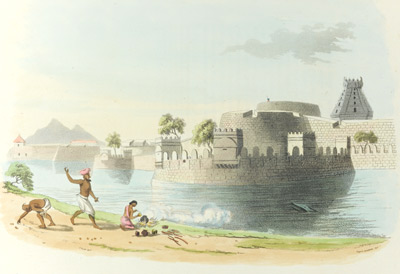
Mysore was devastated by succesive military campaigns during the last three decades of the eighteenth-century. The fourth and final campaign ended with the death of Tipu Sultan in 1799.
Half of the Royal treasury and half of the territory was taken by the victors (who included Colonel Arthur Wellesley, the future 1st Duke of Wellington).
Tipu's wives and children, and several hundred women from the royal household were transported to Madras, on the East coast of India, where they were imprisoned at Fort Vellore, a European style castle surrounded by an aligator-filled moat. Gold’s image of their prison shows villagers throwing stones at an open-mouthed aligator guard.
|
Lal Bagh
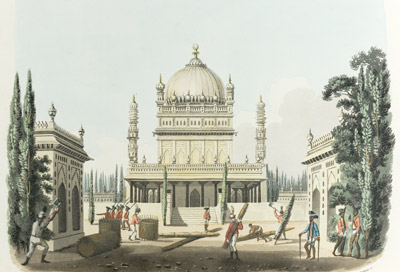
Shortly before Tipu’s defeat British soldiers occupied the Lal Bagh Garden, the site of his father's mausoleum.
They made firewood of the ornamental Cypress trees that had surrounded the tomb; exercised their horses on the manicured lawns; used the buildings and monuments for target practice; used areas set aside for meditation as latrines; and buried their dead in the flower-beds.
This desecration and destruction was within sight of the Royal Palace where Tipu's family were imprisoned before being transported to Vellore.
|
Flying Foxes and Banyan Tree
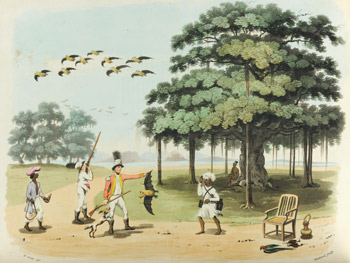
Gold’s images illustrate the change in attitude towards India that had taken place during the preceding thirty years of British conquest. Gone is the sense of wonder at India expressed during the first wave of European Romanticism. In its place is a view of Indian culture as degenerate.
Flying Foxes and Banyan Tree demonstrates this change. Whereas in previous decades the spiritual meaning of the Banyan tree in Hindoo cultural life had been acknowledge and represented with respect, in Gold’s drawing it becomes the backdrop to a scene showing a British officer shooting flying-foxes for sport. An Indian attendant carries water for the officers’ whisky, and a Seepoy reloads rifles. A naked ascetic perches beneath the tree. The scene is a parody of a shooting party on an English country estate.
|
Pandoram
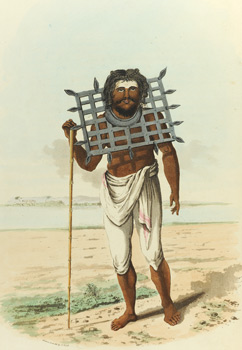
Oriental Drawings is a sort of latter-day cabinet of curiosities filled with fanatics and freaks.
To emphasise the impression of religious dementia shown in “A Pandoram, or religious enthusiast”, Gold draws the sadhus eyes rolling skyward. The accompanying text tells us that Pandoram sects are held in the highest veneration. “They resolve never to sleep comfortably and so wear iron grills that hold oil lamps. This figure had sixteen such lamps and a forehead smeared with cow-dung ashes.”
|
A Dubash
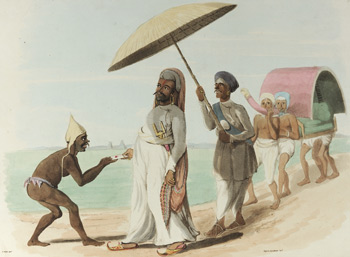
Degeneracy is a prominent theme of Gold’s book. The text which accompanies this image explains that traditionally dubashes were high-born educated stewards but that they had degenerated into cheats who attached themselves to “conniving Europeans”.
He describes them further by paraphrasing the notorious General Hector Munro, who, when fighting against the Scottish rebellion of Bonnie Prince Charley in 1745, referred to kilt-wearing Highlanders as ‘husseys with whiskers’. (In India Munro executed mutinous native soldiers by strapping them to the end of canon and blasting them to pieces.)
|
A Female Brahmin
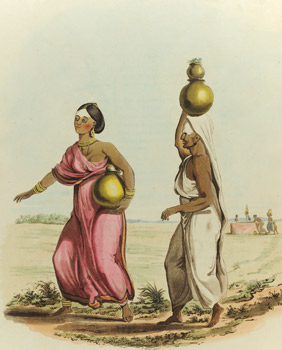 Throughout the nineteenth-century images such as those created by Gold were used to support pseudo-ethnologies and a ‘race science’ that ranked people and cultures according to their ‘relative development’.
Throughout the nineteenth-century images such as those created by Gold were used to support pseudo-ethnologies and a ‘race science’ that ranked people and cultures according to their ‘relative development’.
The text accompanying this image tells us that the women of the Coromandel Coast are generally “of small stature, have good figures, and some have such pleasing and delicate features that were it not for their complexions, they might be termed beautiful”.
We are informed that one of the figures is a widow who did not commit sati, the immolation of widows that so horrified Europeans.
|
A Female Devotee
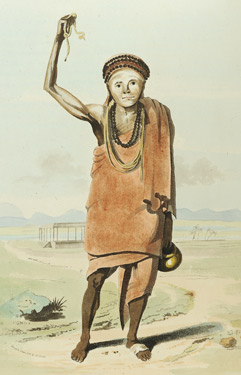 Gold includes several studies of what he describes as religious fanaticism.
He states that “This woman made a vow, in order to gain the favour of the Gods, to keep her right arm uplifted, and let the fingernails of that hand grow for twelve years.
The cord she carries round her neck she uses for the purpose of tying up her arm at night when going to rest. In no country has fanaticism been carried to a more extravagant length than in India, where a large proportion of all the natives still persevere on dragging on a miserable existence of religious beggary”.
Gold includes several studies of what he describes as religious fanaticism.
He states that “This woman made a vow, in order to gain the favour of the Gods, to keep her right arm uplifted, and let the fingernails of that hand grow for twelve years.
The cord she carries round her neck she uses for the purpose of tying up her arm at night when going to rest. In no country has fanaticism been carried to a more extravagant length than in India, where a large proportion of all the natives still persevere on dragging on a miserable existence of religious beggary”.
|
Barbarous Ceremony
This image shows various forms of mutilation and ritual self-inflicted pain allegedly performed in honour of Mariatale, Goddess of Smallpox.
High on the surrounding temple buildings the depiction of human onlookers parodies temple sculptures and friezes.
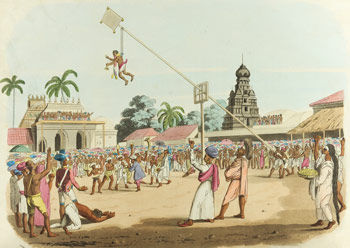
A devotee is suspended from a pole.
The ropes from which he swings are attached by metal hooks inserted in his back - and he is smiling.
His helmet and shield mark him as a soldier of Tipu.
Gold explains that he witenessed the ceremony at Negapatam, near French Pondicherry, the city Sir Hector Munro had captured from Tipu’s father, Hyder Ali, in 1781.
The image implies that the man enjoys pain, a reputation shared by Tipu and his so-called Tiger-soldiers.
|
Beggars
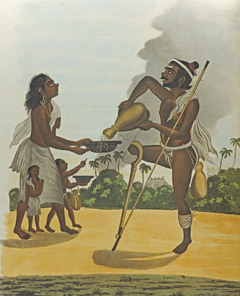 This image was produced by an Indian artist.
The figures are out of proportion. The children at the woman’s knee appear like young dwarfs.
Gold explains that the man’s leg was amputated as punishment for theft, the rationale being that if he committed further crimes, then with just one leg he would be easier to catch.
This image was produced by an Indian artist.
The figures are out of proportion. The children at the woman’s knee appear like young dwarfs.
Gold explains that the man’s leg was amputated as punishment for theft, the rationale being that if he committed further crimes, then with just one leg he would be easier to catch.
|
Rolling Pilgrimage
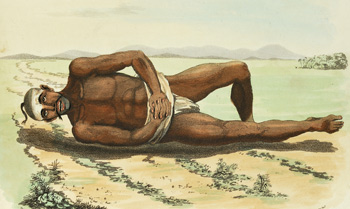 The person represented, in the hope of gaining the favor of his God, resolved to travel from the Braminical church on Trichinopoly rock, to the famous temple on the hill at Pylney, a distance of more than one hundred miles, by rolling the whole way on the ground. Being a man of considerable property, he was enabled to soften the toils inseperable to a poor enthusiast from such an undertaking, by the attention of two servants, who preceding cleared the roads of all moveable impediments, and, whenever he thought proper t0 end a stage, prepared refreshments for him. The only piece of dress worn by him was a calico cloth wrapped about the waste; his hair was close shaved, excepting a small lock on the back part of the crown, and his head entirely exposed to the influence of the sun and reflected heat from the ground, which it nearly touched every revolution he made. The person represented, in the hope of gaining the favor of his God, resolved to travel from the Braminical church on Trichinopoly rock, to the famous temple on the hill at Pylney, a distance of more than one hundred miles, by rolling the whole way on the ground. Being a man of considerable property, he was enabled to soften the toils inseperable to a poor enthusiast from such an undertaking, by the attention of two servants, who preceding cleared the roads of all moveable impediments, and, whenever he thought proper t0 end a stage, prepared refreshments for him. The only piece of dress worn by him was a calico cloth wrapped about the waste; his hair was close shaved, excepting a small lock on the back part of the crown, and his head entirely exposed to the influence of the sun and reflected heat from the ground, which it nearly touched every revolution he made.
When the writer saw him, he was concluding his pilgramage, by rolling thro' the fort of Trichinopoly, "singing or rather crying aloud, the praises of God."
The Monlthy magazine, Volume 10
|
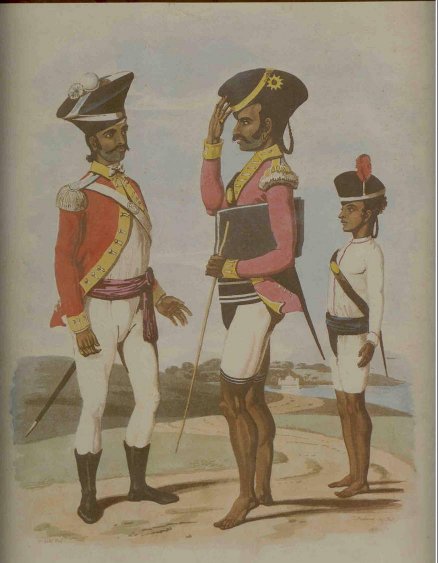
Sepoys of the Madras Establishment |
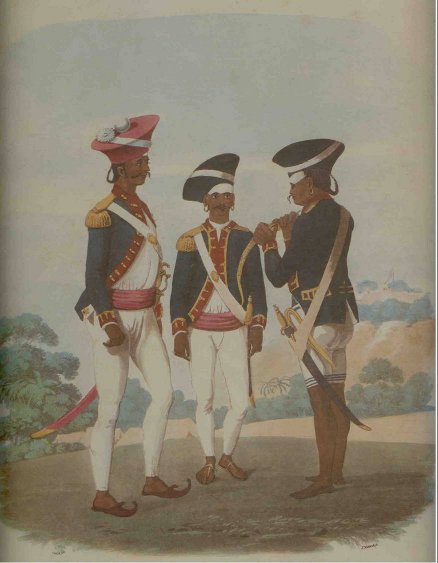
Officers and Private of the Gun Lascar Corps, Madras Establishment |
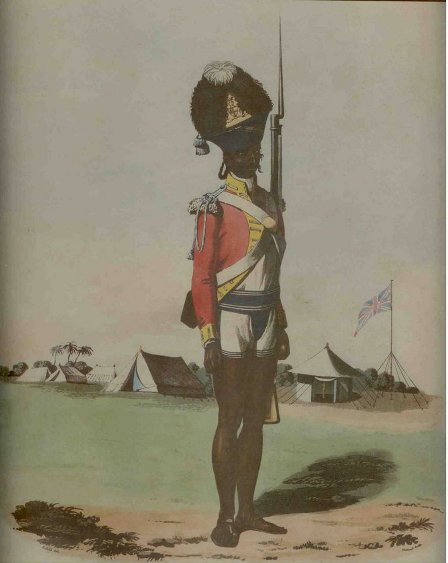
A Naigue of the Bombay Grenadier Battalion |
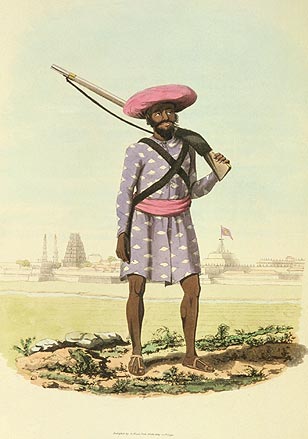 Mysore Regular Infantry. Mysore Regular Infantry.
In the text which accompanies this plate, Gold quotes 'from a paper written during the last war, by the late Lieut. Ewan Bushby of the Bengal establishment' dated 1st September 1795:
'The dress of the regular infantry is generally of purple woollen stuff, with white diamond formed spots on it, which is called the tyger jacket. On the head is worn a muslin turban, of a red colour, and round the waist a cumberband, or sash, of the same.
Their legs and feet are entirely naked, excepting a kind of sandal slipper, worn to protect their soles from the roughness of the march.
They are accoutred with black leather cross belts, and commonly armed with musquets of French manufacture; though some are made in their own country; over the lock is a leather covering, to defend it from dampness."
In the distance, a part of the north west front of Seringapatam is seen.
The twin minarets of Tipu's Masjid e'Ala, the great Sriranatha-svami temple and the flagstaff cavalier are clearly visible on the skyline.
Tipu, the French and the English, all employed sepoy regiments, many of whom are commemorated on the monument which stands at the point where the British breached the walls of Seringapatam. |
|
|
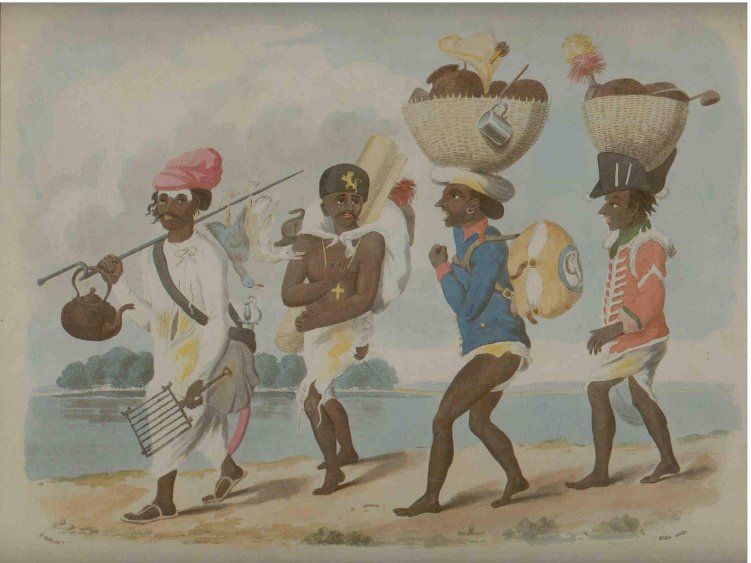
A Cuisinegerra and Soldiers' Cookboys |
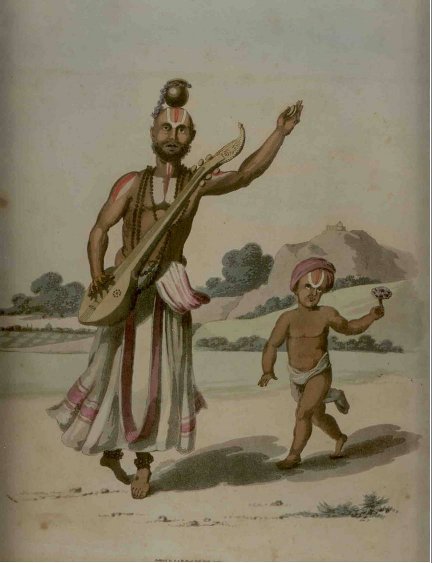
A Satadevan and His Son.
See Rabbiting On for a discussion of the etymology of Satadevan. |
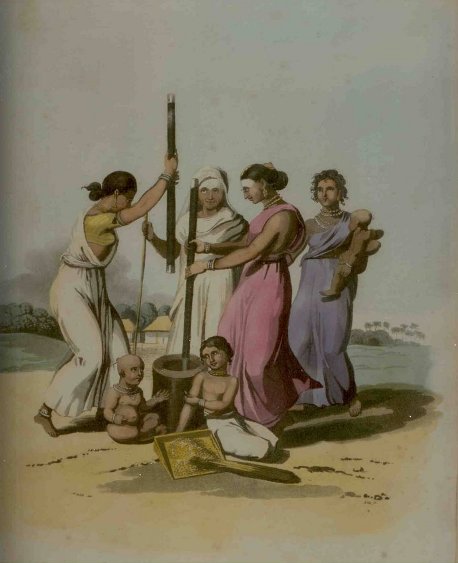
Women at Work |
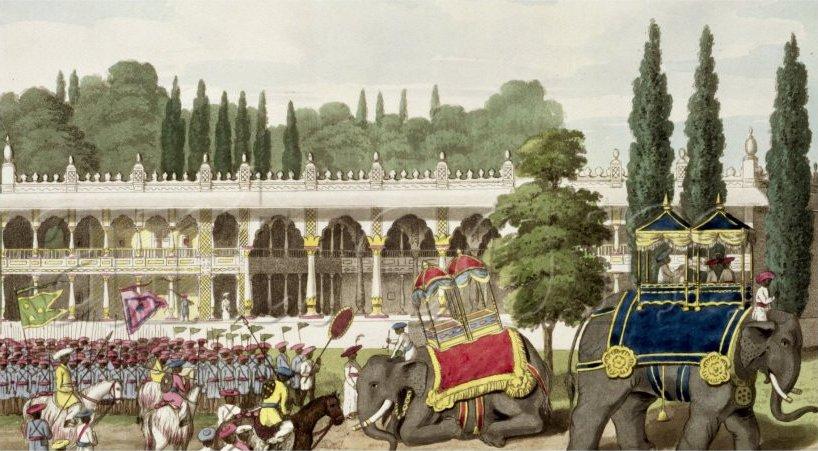
Tipoo's Palace |
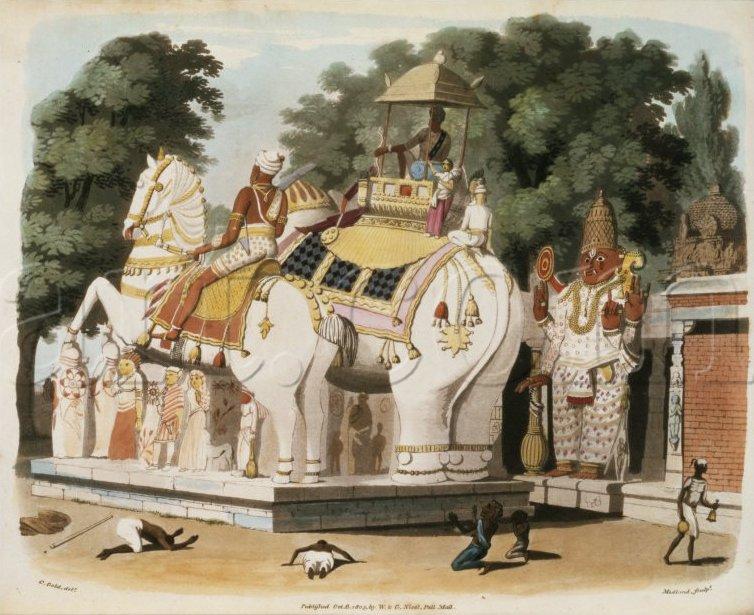
Natives Pay Homage To Their Ruler |
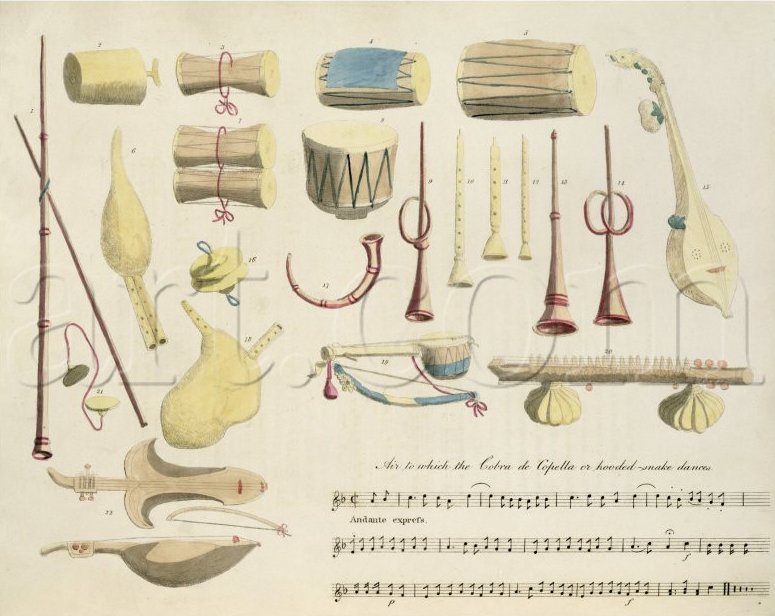
Indian Musical Instruments |
The images below are modern versions based on Gold's picturessourced from: www.1st-art-gallery.com, www.artchive.com, www.niceartgallery.com or www.wikigallery.org. The 3 above from www.art.com may also be modern. |
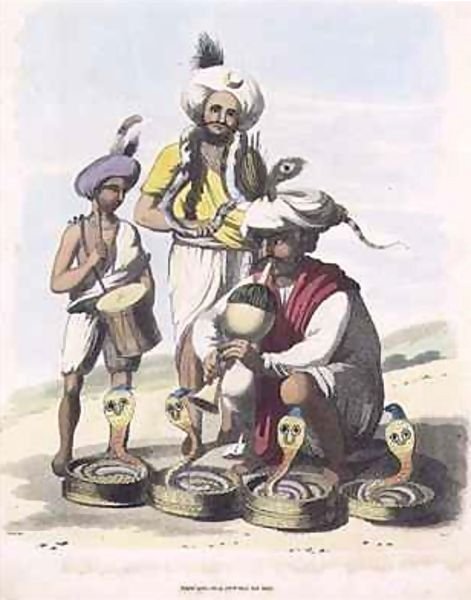
Snake Charmers near the Village of Manupar |
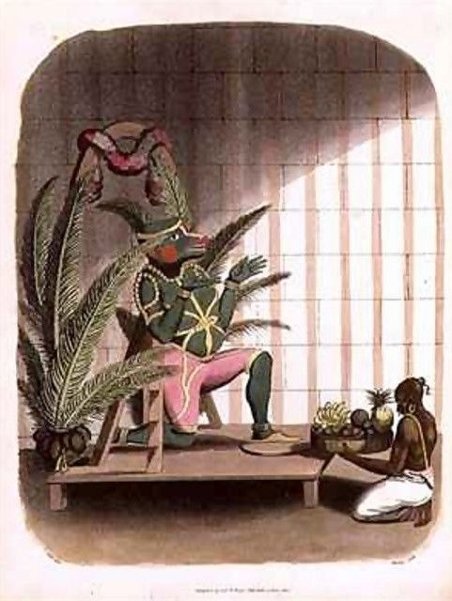
Hanuman |
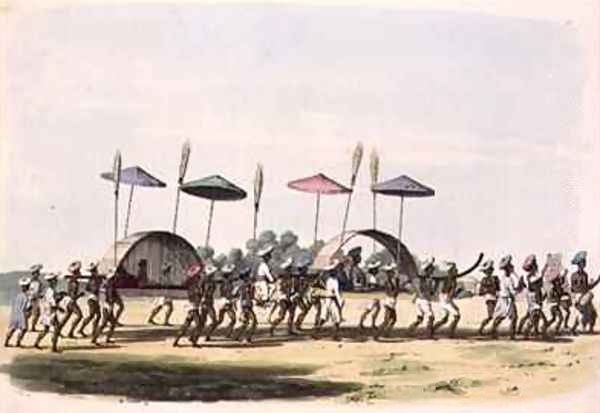
Marriage Procession through the Town of Nagappattinam |
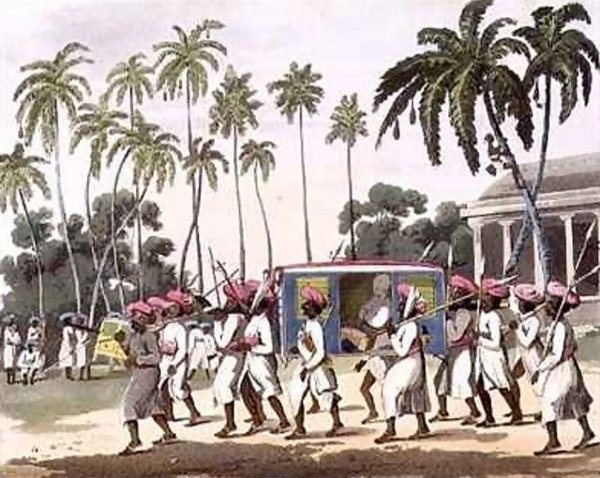
Palankeens |
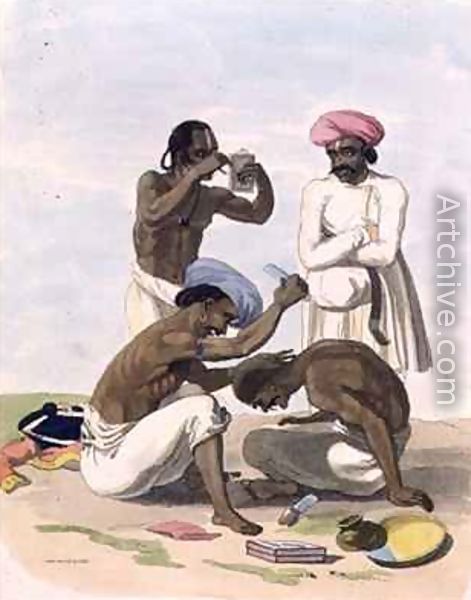
Barbers |
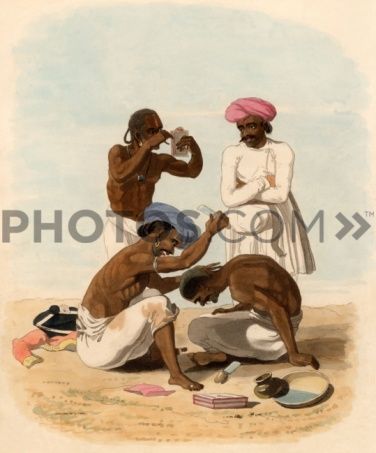
Barber (from photos.com)
Compare the modern painting to the left with the one above. Differences include the stains on the pantaloons and the water level in the tray.
Some sites advertise modern versions as 'by Gold', while others use 'after Gold'.
|


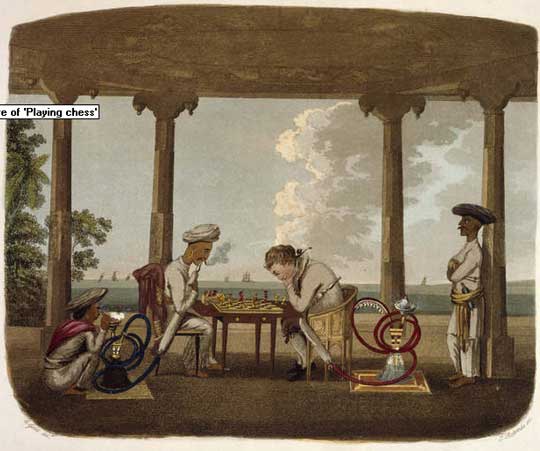



 Mysore Regular Infantry.
Mysore Regular Infantry.











